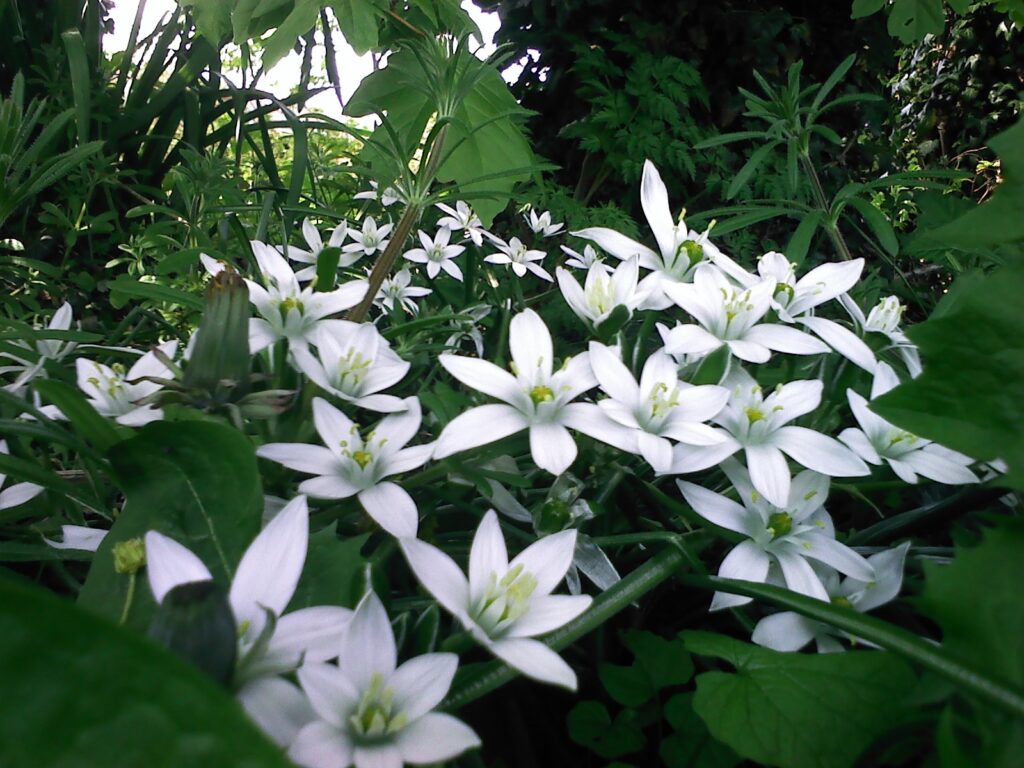
This and the previous post are about a number of native families which in the ‘Wild Flower Key’ are lumped together into the one Liliaceae but are in fact classified in different families according to Stace.
Again, similar to the previous post this has several good garden plants which have established themselves often very happily in the wild!
The debate of native and non-native and what to include in my blog will be more and more difficult in future as rare endemics will not be known by many and certainly should not be ‘used’ in any way! Common, ornamental plants will be more accessible to all and get established in the wild more and more for everybody to use! They will become in fact our new ‘weeds’!
Click links for more info and pictures of the plants from various websites. Scientific/Latin Name usually has a link from the Online Atlas of the British Isles and Irish Flora. Pink background means a warning (such as poisonous!) or medicinal use, green for edible or other uses and blue for habitat where it can be found in B.I. , interesting facts or wildlife use.
Contents are included to easily jump to right genus on next page!
Pictures with thanks by Matt Summers, Mike Poulton of Ecorecord and Wikipedia .
Contents:
ASPARAGACEAE – Asparagus family
Lily-of-the-Valley
- Convallaria majalis or Lily-of-the-valley
Solomon’s -seals
- Polygonatum multiflorum or Solomon’s- seal
- Polygonatum x hybridum (P. multiflorum x P. odoratum) or Garden Solomon’s- seal
- Polygonatum odoratum or Angular’s Solomon’s-seal
- Polygonatum verticillatum or Whorled Solomon’s-seal
May Lily or Maianthemum bifolium
Ornithogalums
- Ornithogalum pyrenaicum or Spiked Star-of-Bethlehem or Bath Asparagus
- Ornithogalum umbellatum or Star-of-Bethlehem
Scilla or Squills
- Scilla verna or Spring Squill
- Scilla autumnalis or Autumn Squill
Bluebells
- Hyacinthoides non-scripta or Bluebell
- Hyacinthoides hispanica or Spanish Bluebell
- Hyacinthoides x massartiana (= H. hispanica x H. non-scripta) or Hybrid Spanish Bluebell
Grape-hyacinth or Muscari neglectum
Asparagus
- Asparagus prostratus or Wild Asparagus
- Asparagus officinalis or Garden Asparagus
Butcher’s-broom or Ruscus aculeatus
Herb-Paris Family or MELANTHIACEAE
- Paris quadrifolia or Herb-Paris
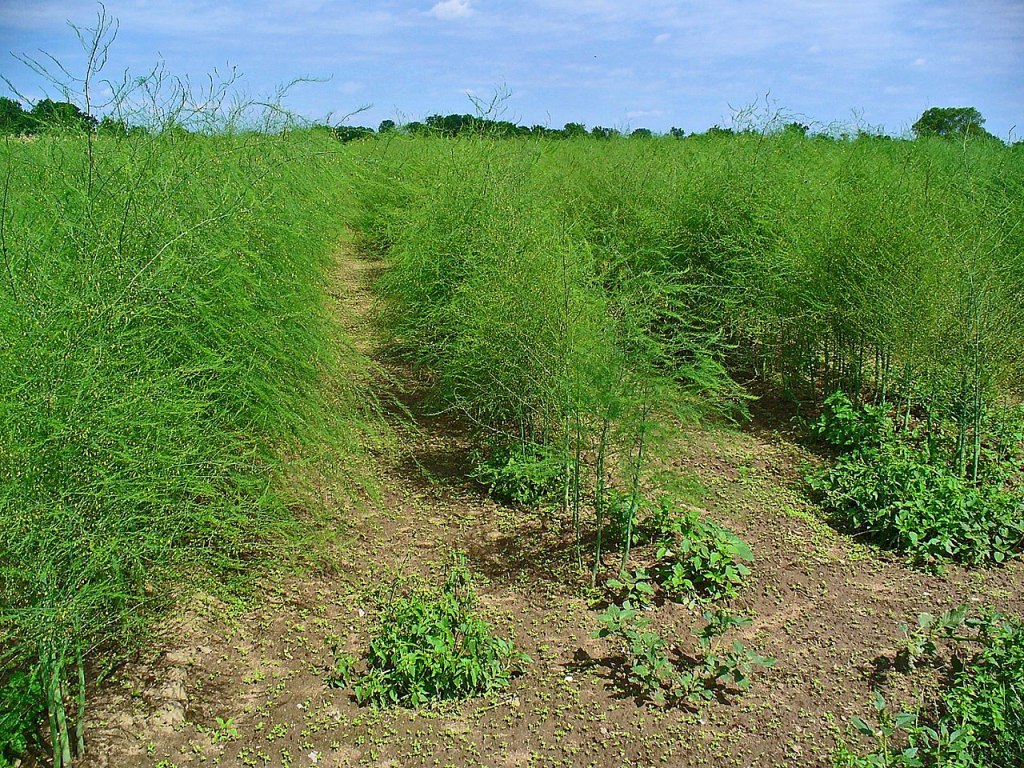
ASPARAGACEAE – Asparagus family
This family has 14 genera mentioned in Stace but only half are true natives.
Lily-of-the-Valley
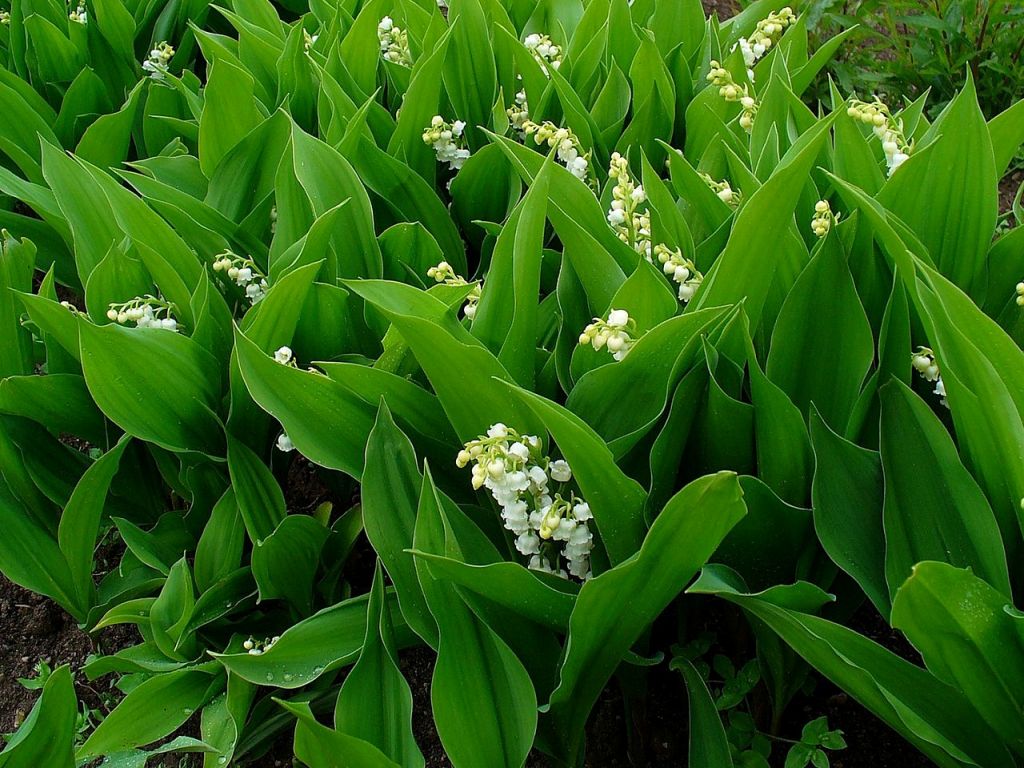
Convallaria majalis or Lily-of-the-valley
A rhizomatous perennial herb of freely-draining, nutrient-poor soils. It is most frequent in Fraxinus woods on limestone in N. and W. Britain, but also grows in the grikes of limestone pavement, in acidic woods in S.E. England, and in a fen in Cumbria. It is a common garden escape.
Due to the concentration of cardiac glycosides (cardenolides), it is highly poisonous if consumed by humans or animals. All parts of the plant are potentially poisonous, including the red berries which may be attractive to children.
If ingested, the plant can cause abdominal pain, nausea, vomiting, and irregular heartbeats.
Convallaria majalis is used as a food plant by the larvae of some moth and butterfly species including the grey chi. Adults and larvae of the leaf beetle. Lilioceris merdigera are also able to tolerate the cardenolides and thus feed on the leaves.
Convallaria majalis is widely grown in gardens for its scented flowers and ground-covering abilities in shady locations. It has gained the Royal Horticultural Society‘s Award of Garden Merit. In favourable conditions it can form large colonies.
Various kinds and cultivars are grown, including those with double flowers, rose-coloured flowers, variegated foliage and ones that grow larger than the typical species.

- C. majalis ‘Albostriata’ has white-striped leaves
- C. majalis ‘Green Tapestry’, ‘Haldon Grange’, ‘Hardwick Hall’, ‘Hofheim’, ‘Marcel’, ‘Variegata’ and ‘Vic Pawlowski’s Gold’ are other variegated cultivars
- C. majalis ‘Berlin Giant’ and C. majalis ‘Géant de Fortin’ (syn. ‘Fortin’s Giant’) are larger-growing cultivars
- C. majalis ‘Flore Pleno’ has double flowers.
- C. majalis ‘Rosea’ sometimes found under the name C. majalis var. rosea, has pink flowers.
Traditionally Convallaria majalis has been grown in pots and winter forced to provide flowers during the winter months, both for as potted plants and as cut flowers.
In 1956, the French firm Dior produced a fragrance simulating lily of the valley, which was Christian Dior‘s favorite flower. Other makes of perfumes and soaps etc. are made with the Lily of the valley scent.
Medicinal Uses:
The fresh aerial parts of the blooming plant are used in homeopathy as remedy.
Lily of the valley has been used in weddings and can be very expensive.

By Magnus D – Flickr: Extracted from The royal family on the balcony.
It was featured in the bridal bouquet at the wedding of Prince William and Catherine Middleton.
Lily of the valley is worn in Helston (Cornwall, UK) on Flora Day (8 May each year, see Furry Dance) representing the coming of “the May-o” and the summer. There is also a song sung in pubs around Cornwall (and on Flora Day in Cadgwith, near Helston) called “Lily of the Valley”; the song, strangely, came from the Jubilee Singers from Fisk University in Nashville, Tennessee.
Solomon’s -seals or Polygonatum
Young shoots – cooked. They can be used as an asparagus substitute. Root – cooked. Rich in starch.
The fruits are poisonous!
Solomon’s seal has been used for thousands of years in herbal medicine. It is used mainly in the form of a poultice and is believed to prevent excessive bruising and to stimulate tissue repair. It is used in the treatment of, dry throat, dry coughs and coronary heart disease. An infusion is used as a diuretic and stimulant to the metabolism, though no more than 3 cups per day should be taken and only over short periods. It can also be applied externally as a poultice to treat bruises, small wounds etc. It has also been used to remove freckles It should not be used internally except under expert supervision:
There are 4 main species growing on the British Isles:
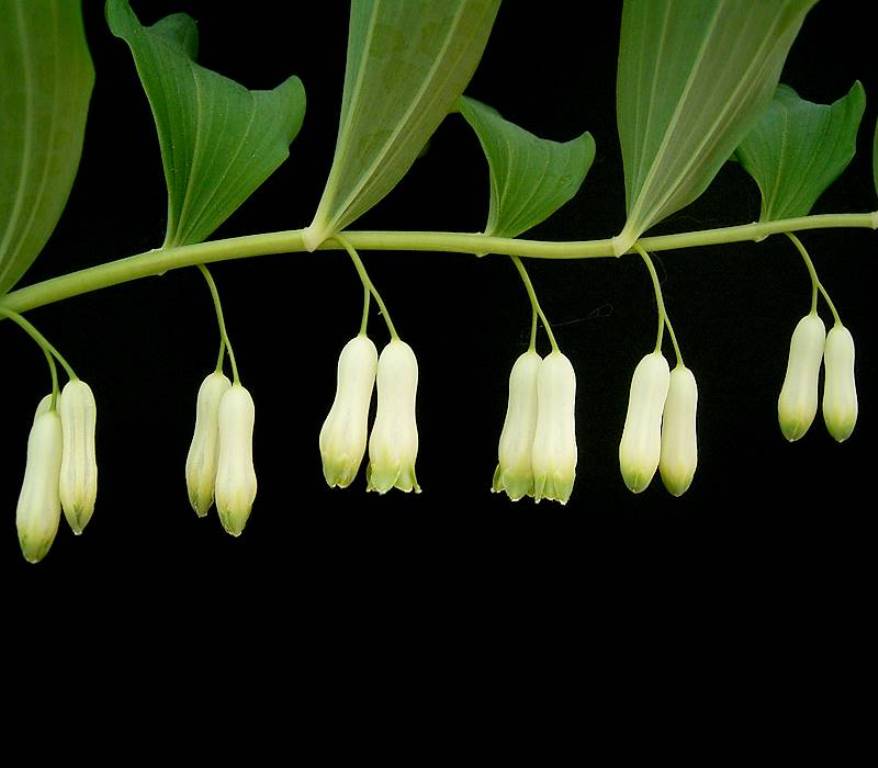
Polygonatum multiflorum or Solomon’s- seal
A rhizomatous perennial herb, native in Fraxinus-Acer campestre woods and thickets over chalk and limestone, and less frequently over non-acidic substrates.
Polygonatum x hybridum (P. multiflorum x P. odoratum) or Garden Solomon’s- seal
A rhizomatous perennial herb of woodland margins, churchyards, hedgerows, roadsides and rough ground. It is usually sterile.
Garden and Wildlife Uses:
It is suitable for sunny or partially shaded positions and is described as easy to grow. It has gained the Royal Horticultural Society‘s Award of Garden Merit.
In gardens it is susceptible to attack by the larvae of Solomon’s seal sawfly (Phymatocera aterrima), which feed on the underside of the leaves, rapidly reducing them to a skeletonised appearance.
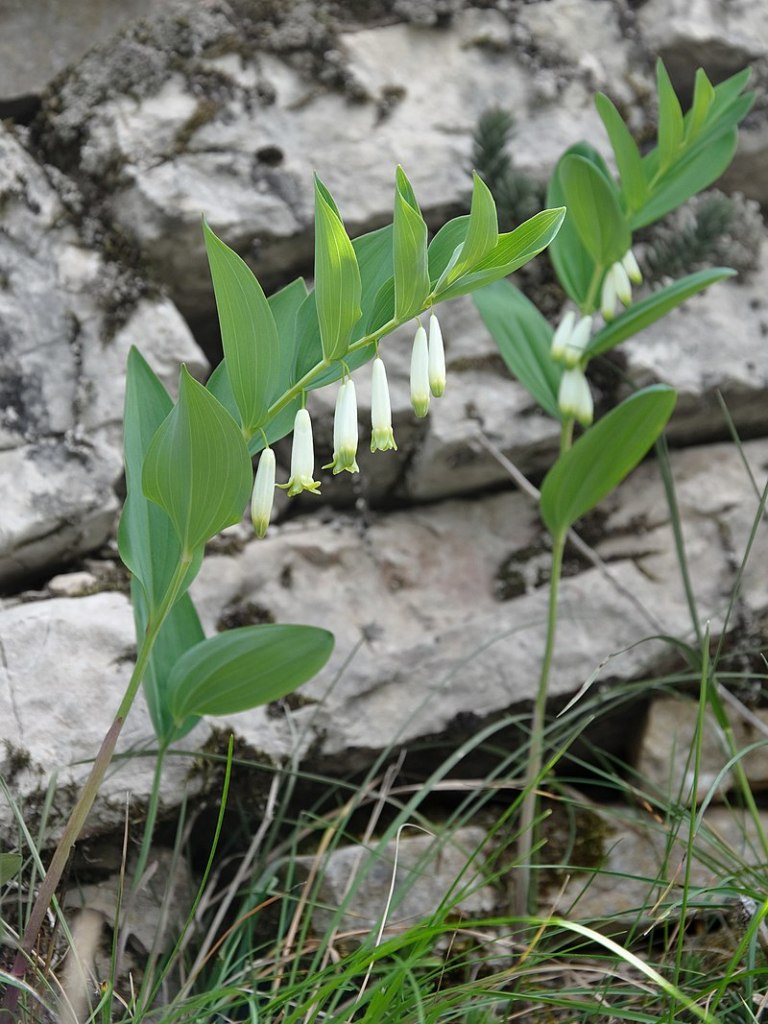
Polygonatum odoratum or Angular’s Solomon’s-seal
A rhizomatous, perennial herb of ancient Fraxinus woods, often growing in crevices and on outcrops of limestone. In N. England it is characteristic of grikes in limestone pavement.
P. odoratum is a perennial with arching stems bearing elliptic leaves and, in each axil, one or two fragrant, tubular, green-tipped, creamy-white flowers.
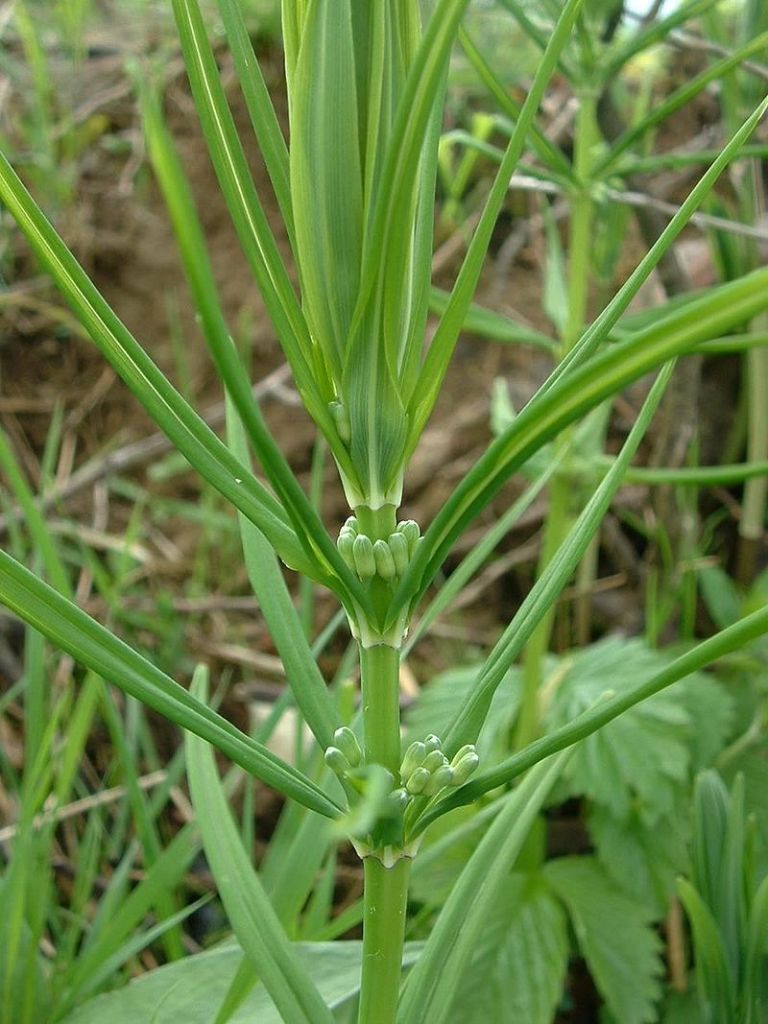
Polygonatum verticillatum or Whorled Solomon’s-seal
A rhizomatous, perennial herb usually found on moist, nutrient-rich, usually basic, soils in wooded gorges and on a wooded river bank.
It’s an ayurvedic medicine and used in Chinese herbal medicine. See for more info at the links provided.
May-Lily
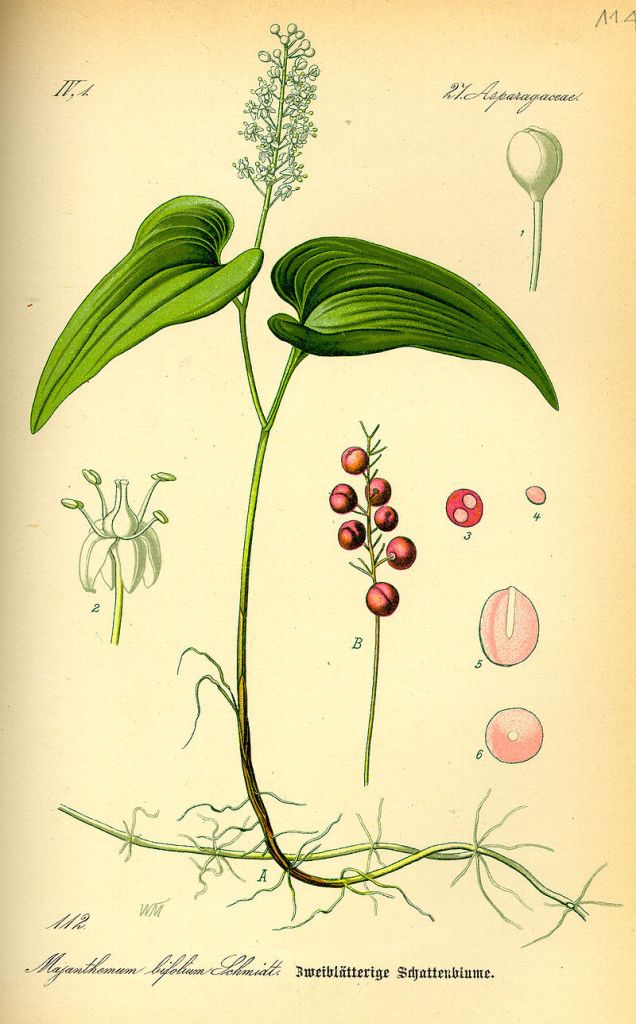
Maianthemum bifolium or May Lily
A rhizomatous, perennial herb of free-draining acidic soils in Quercus-Betula woodlands, but also persisting at sites replanted with conifers. Flowering and seed-set is poor.
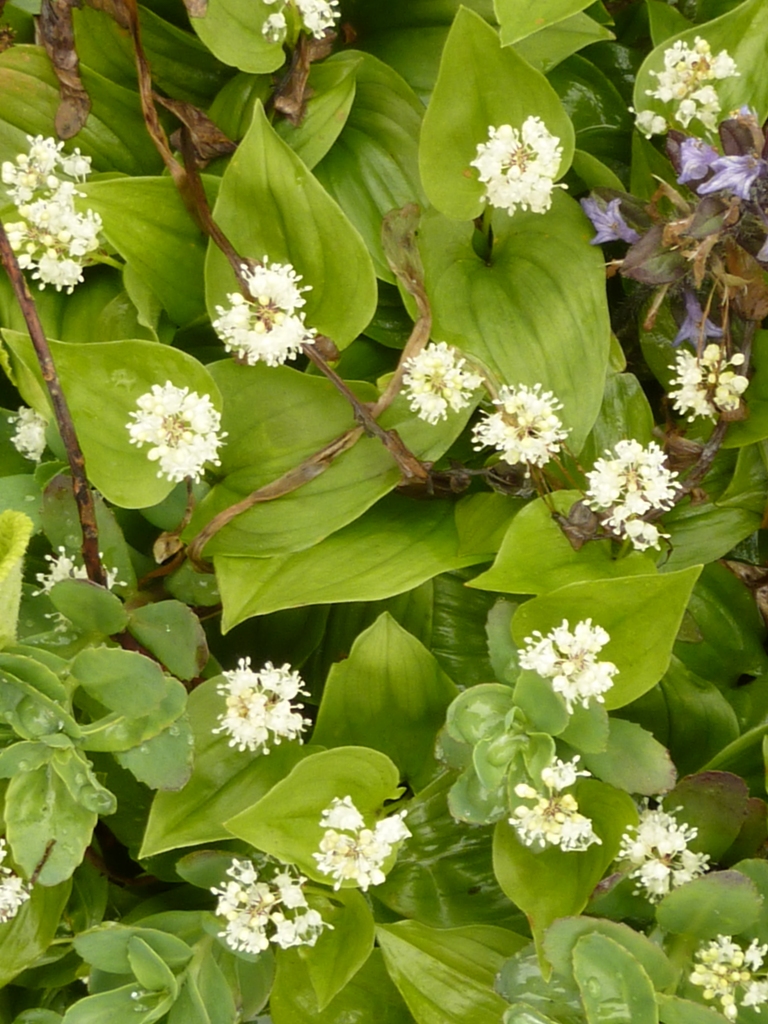
This is a spreading herbaceous perennial, up to 15-20cm high, with glossy, dark green, heart-shaped or ovate leaves, 8cm across. Creamy-white flowers in late spring are followed by small round fruits which start pale green before turning red.
Ornithogalums

Ornithogalum pyrenaicum or Spiked Star-of-Bethlehem or Bath Asparagus
A bulbous perennial herb of Fraxinus-Ulmus woodland, hedgerows, road verges and rough grassy banks on calcareous soils, and a particular feature of green lanes on the borders of Somerset and Wiltshire.
The common name Bath asparagus comes from the fact that it was once abundant near the city .
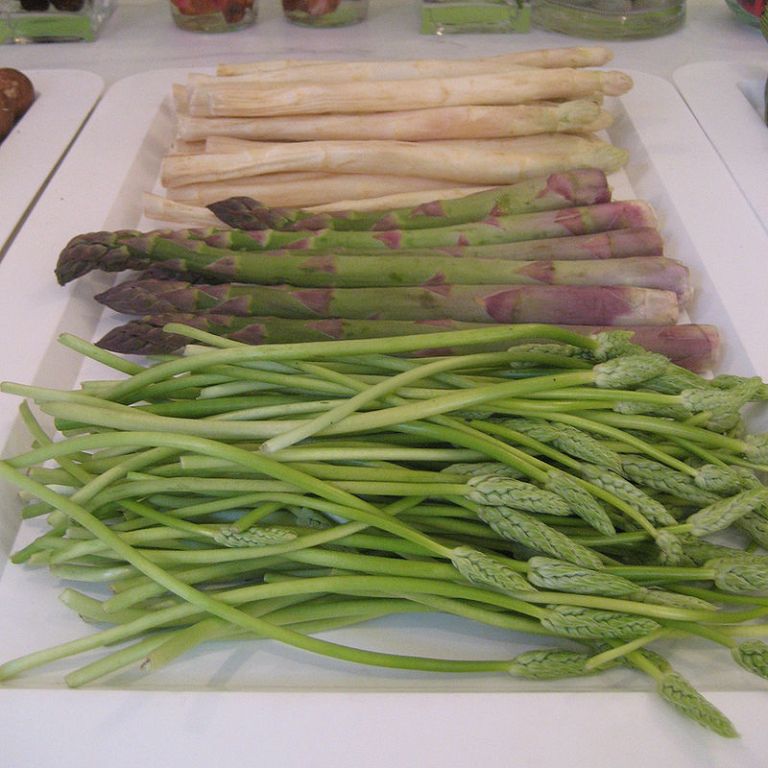
Young shoots – cooked. The young, unexpanded flowering shoots are cooked and served like asparagus.
Skin contact with the bulb can cause dermatitis in sensitive people[65]. Any toxins in this plant are concentrated in the bulb.
Bath Asparagus, also known as Spiked Star of Bethlehem, is a handsome plant with narrow, glaucous leaves and a flower spike that can reach up to 2ft high and contain as many as fifty flowers. Each flower is slightly less than an inch across and is star shaped with six, green striped, greenish-white petals. Flowers can be found throughout June and July.

Ornithogalum umbellatum or Star-of-Bethlehem
A bulbous spring-flowering perennial herb, widely grown in gardens and naturalized in grassy places, rough ground, arable margins, roadsides, tracksides, old meadows and pastures and in open woodlands. It reproduces primarily by bulblets which are likely to be dispersed in soil or garden waste. It is found also as a persistent relic of cultivation.
Skin contact with the bulb can cause dermatitis in sensitive people. The bulb contains alkaloids and is poisonous. Another report says that the bulb is poisonous to grazing animals.
Bulb – raw or cooked. The bulbs can be dried and ground into a powder. Whilst the bulbs are palatable and wholesome according to some reports, some caution is advised. See the notes above on toxicity. Flowers – baked in bread.
A homeopathic remedy is made from the bulbs. It is useful in the treatment of certain forms of cancer. The plant is used in Bach flower remedies – the keywords for prescribing it are ‘After effect of shock, mental or physical. It is also one of the five ingredients in the ‘Rescue remedy’
Ornithogalum umbellatum is a lovely wildflower often spreading rapidly by offsets, with linear leaves each with a white mid-vein, and umbel-like racemes of star-shaped white flowers, green on the outside, in early summer.
Scilla or Squills
Stace lists 11 species but only two are true natives:
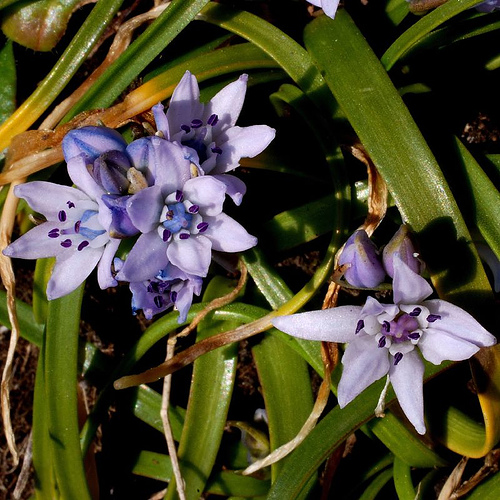
Scilla verna or Spring Squill
A bulbous perennial herb of short turf and maritime heath on exposed cliff-tops and on rocky slopes near the sea, sometimes within the zone regularly affected by sea-water spray. In areas with a pronounced oceanic climate (e.g. Anglesey) it can occur on heathland well inland.
It is one of the key components of the H7 plant community in the British National Vegetation Classification system. It was chosen as the county flower for County Down in Northern Ireland after a public vote organised by the charity Plantlife in 2002.
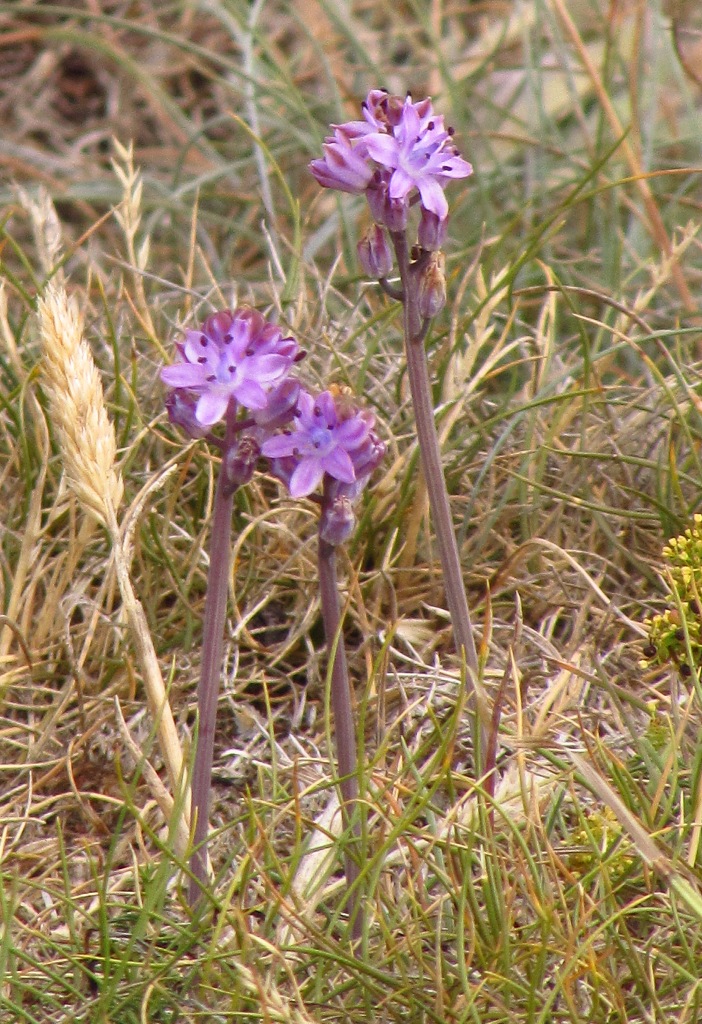
Scilla autumnalis or Autumn Squill
A bulbous perennial herb of open, drought-prone grasslands and heathy vegetation in rocky or sandy places near the sea; also on terrace gravels in the lower Thames valley.
This is an attractive wildflower to 25cm, with dense racemes of small purple flowers appearing in late summer and early autumn, before the linear leaves.
Bluebells

Hyacinthoides non-scripta or Bluebell
A bulbous perennial herb occurring, sometimes abundantly, in a wide variety of deciduous woodlands, in hedgerows, on shady banks and, especially in western and upland areas, in meadows, under Pteridium and on cliffs. It also occurs as a naturalised garden escape. It is sensitive to long-term grazing.
In the United Kingdom, H. non-scripta is a protected species under the Wildlife and Countryside Act 1981. Landowners are prohibited from removing common bluebells on their land for sale and it is a criminal offence to remove the bulbs of wild common bluebells.
Bluebells are widely planted as garden plants, either among trees or in herbaceous borders.They flower at the same time as hyacinths, Narcissus and some tulips. Their ability to reproduce vegetatively, using bulb offsets and seed, means that they can spread rapidly.
In common with other members of their genus, bluebells – particularly their bulbs – are normally considered to be toxic. Bluebells synthesise a wide range of chemicals with potential medicinal properties: they contain at least 15 biologically active compounds that may provide them with protection against insects and animals.
Certain extracts – water-soluble alkaloids – are similar to compounds tested for use in combating HIV and cancer. The bulbs of bluebells are used in folk medicine as a remedy for leucorrhoea, and as a diuretic or styptic,
- A glue is obtained from the sap in the bulb and stem. Simply cut open a bulb and apply the sap to whatever needs to be joined[K]. It makes an excellent paper glue, the join is stronger than the surrounding paper. It would not work on non-absorbent materials such as plastics and glass[K].
- A starch from the bulb has been used in laundering, it is very harsh on the skin.
The bluebell may be regarded as the United Kingdom’s “favourite flower”. When the wild plant charity Plantlife organised a survey in 2004 to find a favourite flower for each county in the United Kingdom, it decided to ban voters from choosing the bluebell because it had been by far the top choice in an earlier poll for the nation’s favourite flower. A stylised bluebell is used as the logo for the Botanical Society of Britain and Ireland.
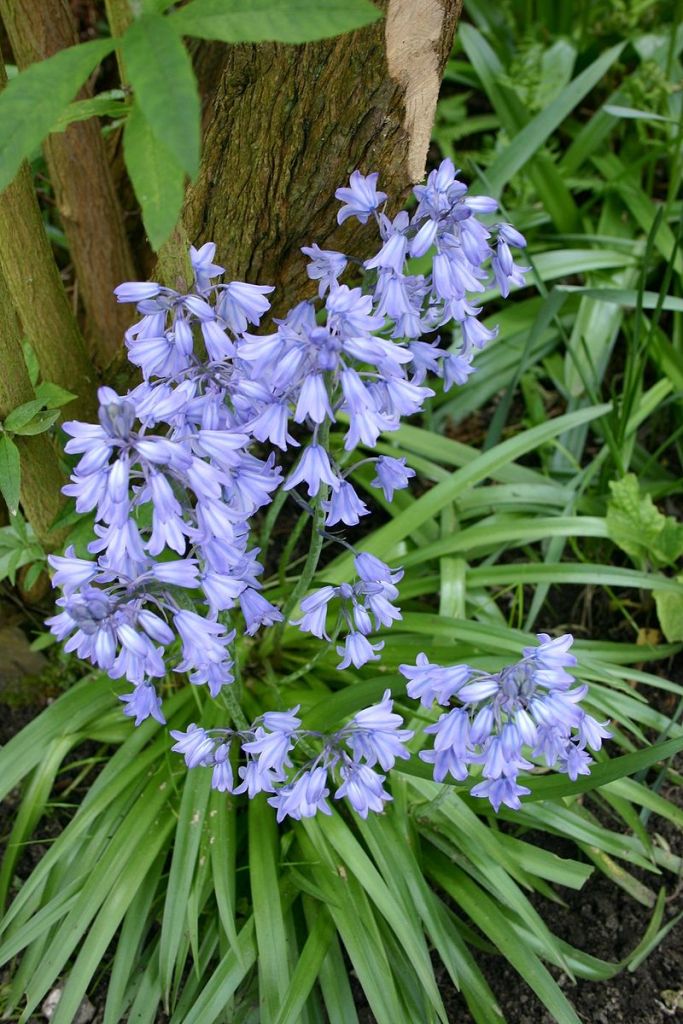
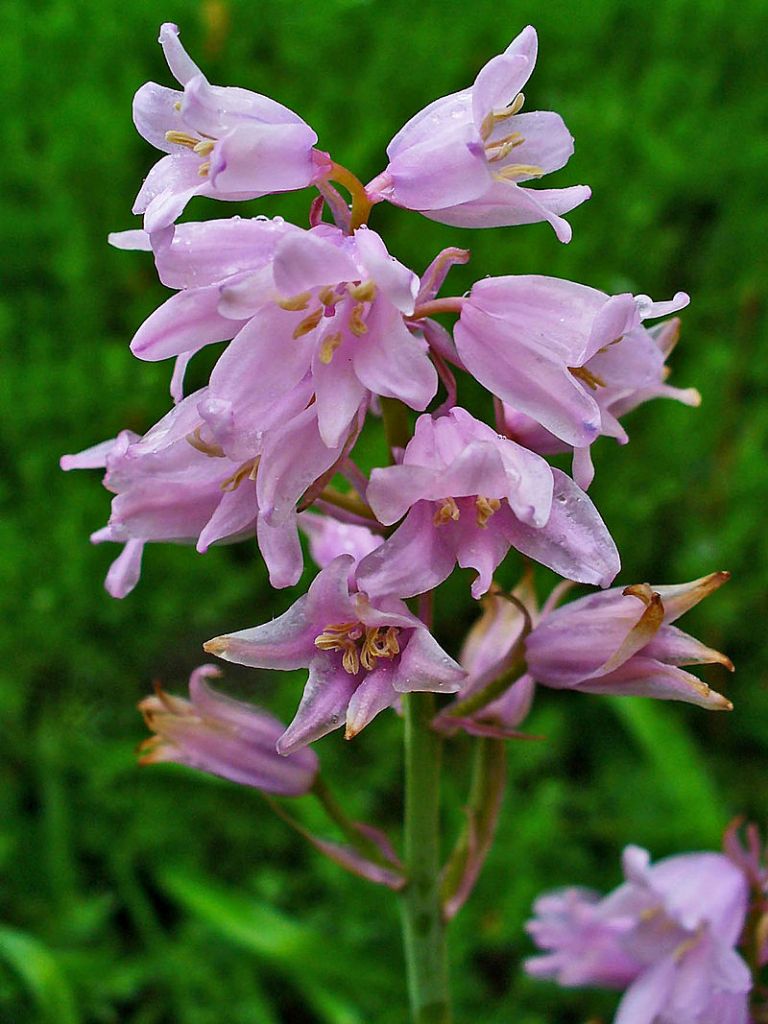
Hyacinthoides hispanica or Spanish Bluebell
The Spanish bluebell was introduced in the United Kingdom. Since then, it has hybridised frequently with the native common bluebell and the resulting hybrids are regarded as invasive. The resulting hybrid Hyacinthoides × massartiana (see below) and the Spanish bluebell both produce highly fertile seed but it is generally the hybrid that invades areas of the native common bluebell. This has caused the common bluebell to be viewed as a threatened species.
The Spanish bluebell is also cultivated as a garden plant, and several named cultivars exist with flowers in various shades of white, pink and blue.
It is distinguished from the common bluebell by its paler and larger blue flowers, which are less pendulous and not all drooping to one side like the common bluebell; plus a more erect flower stem (raceme), broader leaves, blue anthers (where the common bluebell has creamy-white ones) and little or no scent compared to the strong fragrant scent of the northern species.

Hyacinthoides x massartiana (= H. hispanica x H. non-scripta) or Hybrid Spanish Bluebell
An introduced and naturalized bulbous perennial herb (or Neophyte) of woodlands, hedgerows, churchyards and shady roadsides, rough ground and waste places, probably most frequent in the entrances to amenity woods.
This alien species readily hybridises with Britain’s native Bluebell Hyacinthoides non-scripta, and the resulting hybrids Hyacinthoides x massartiana have invaded many ‘bluebell woods’. Hyacinthoides × massartiana has become widespread across Britain and Belgium, both of which have large populations of H. non-scripta. It is often found on the edges of woodland and roadsides, particularly in urban areas, suggesting that it has spread from gardens planted with H. hispanica.
There is great concern over the effect that the hybrid may have on native H. non-scripta populations, diluting the characteristics of the native species and out-competing it due to H. hispanica‘s robust fertility and the effects of climate change.
The Spanish Bluebell is a spring-flowering bulbous perennial native to Spain and Portugal; however, it has been introduced to many other countries, including Britain and Ireland as an ornamental.
Grape-hyacinth
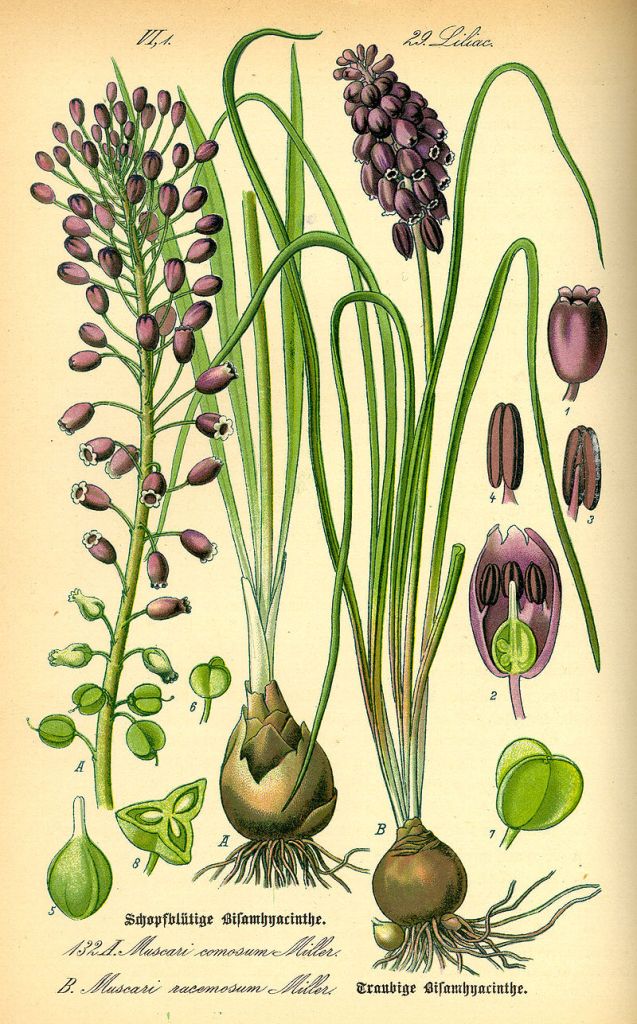
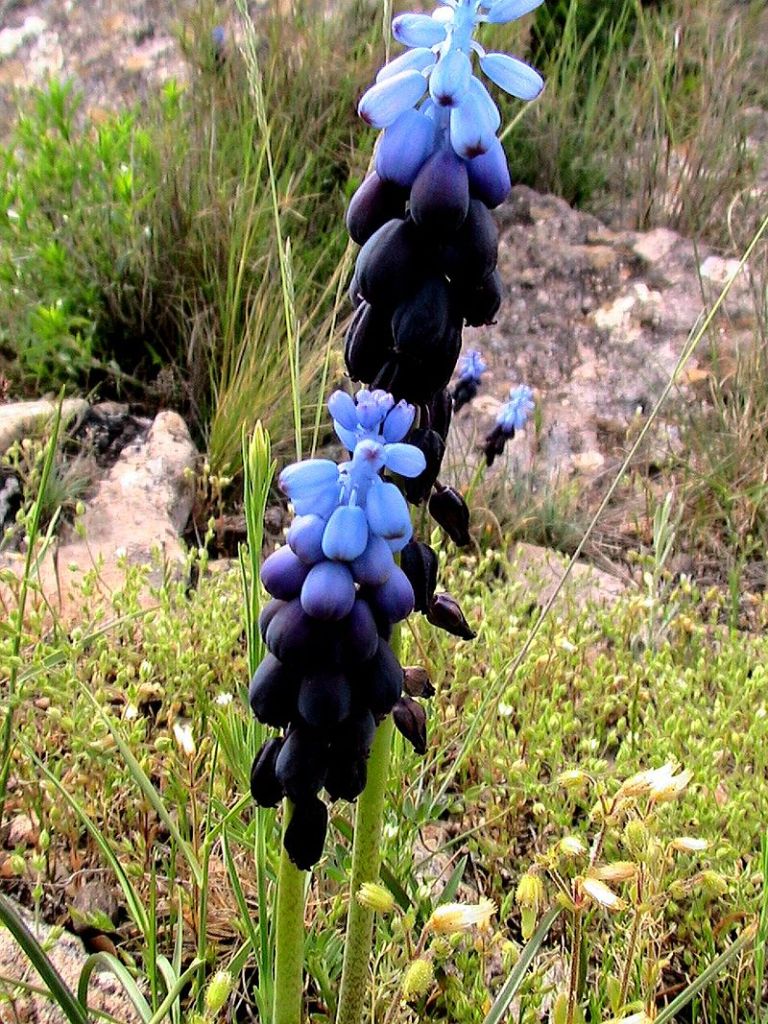
Muscari neglectum or Grape-hyacinth
There are 4 species of Muscari or Grape-hyacinth growing in the British Isles but only the above is a true native.
A bulbous perennial herb on free-draining soils, native or long-naturalised in grasslands, hedgerows, pine plantations and rough ground, and on roadsides on a wide range of nutrient-poor soils. It is also a short-lived garden escape or outcast near habitation, on roadsides, allotments and waste ground.
It is sometimes grown as an ornamental plant, for example, in temperate climates as a spring bulb. But the other species are more often used in particular the Garden Grape-hyacinths: M. armeniacum and M. botryoides.
Asparagus
Asparagus prostratus or Wild Asparagus
A dioecious, rhizomatous perennial herb of free-draining sea-cliffs and sand dunes. On sea-cliffs, the plants often grow through a dense mat of Festuca rubra, usually in very rocky soils. On dunes, it grows in open or closed turf, often by paths.
Wild Asparagus is on the endangered list and should be admired rather than picked.
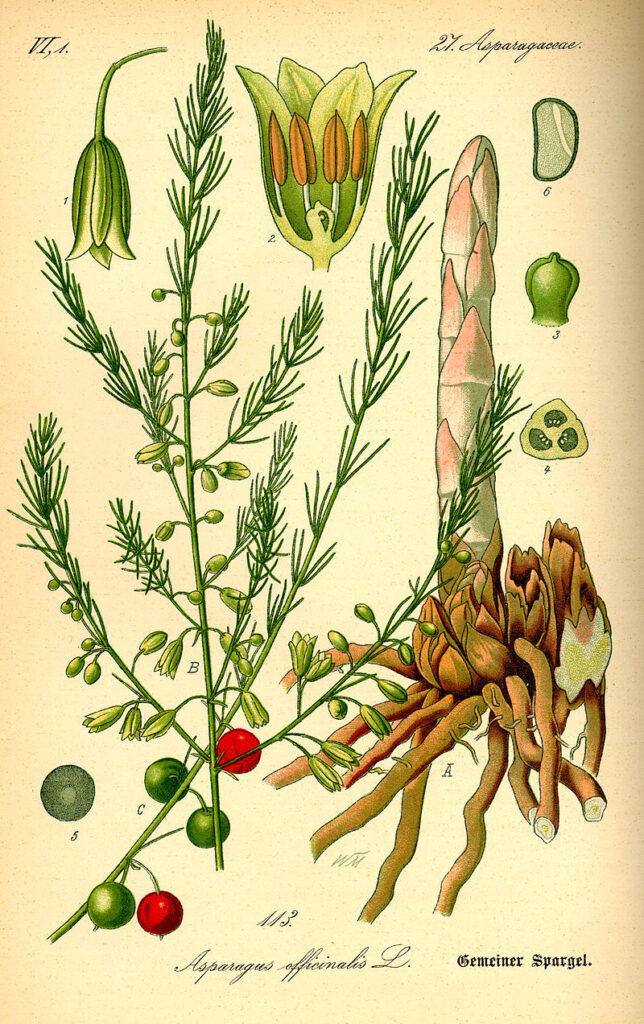
Asparagus officinalis or Garden Asparagus
As this is a post on Asparagaceae the Garden Asparagus should be included!
A dioecious, rhizomatous perennial herb of freely-draining sandy soils. Garden Asparagus readily becomes naturalised, probably mainly by bird-dispersed seed, on grassy heaths and dunes.
Large quantities of the shoots can irritate the kidneys. The berries on the female plants are mildly poisonous.
A. officinalis is grown for its delicately-flavoured young shoots, or spears.

- Young shoots – raw or cooked. Considered a gourmet food; the shoots are harvested in the spring. We find them very acceptable raw in salads, with a hint of onion in their flavour[K].
- They are normally boiled or steamed and used as a vegetable[K]. Male plants produce the best shoots
- The shoots are a good source of protein and dietary fibre.
Asparagus is often cultivated as a luxury vegetable, there are some named varieties. Well-tended plants can be long-lived, an asparagus bed can last for well over 20 years. Asparagus is a good companion plant for tomatoes, parsley and basil. When grown together, tomatoes help to protect asparagus from the asparagus beetle. Asparagus is said to repel the nematodes that can infect tomatoes. The plant contains asparagusic acid, which has nematocidal properties.
- Roasted seeds are a coffee substitute.
- A good bee plant
- The airy, feathery foliage also makes it an attractive herbaceous perennial!
Butcher’s-broom
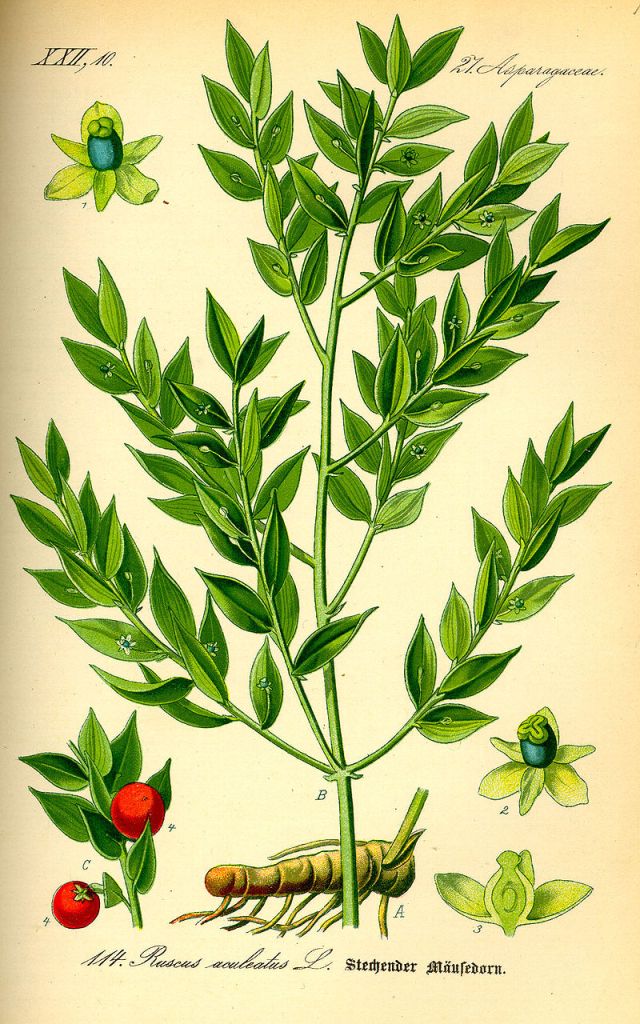
Ruscus aculeatus or Butcher’s-broom
A dioecious, evergreen, rhizomatous shrub, found as a native in dry woods and hedgerows, and on cliffs and rocky ground near the sea. It is also naturalised in similar situations, and in churchyards and near habitation. It reproduces vegetatively by creeping rhizomes, and by seed, which may be bird-sown.
This is a curious plant with flat shoots known as cladodes that give the appearance of stiff, spine-tipped leaves. Small greenish flowers appear in spring, and are borne singly in the centre of the cladodes. The female flowers are followed by a red berry.
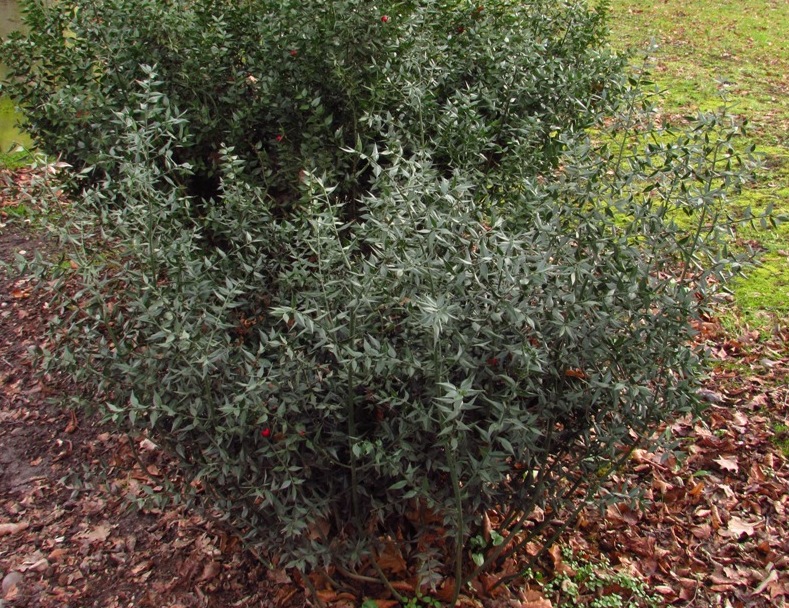
Likely due to its attractive winter/spring colour, and tolerance of dry shade, Ruscus aculeatus is a useful landscape and garden plant.
The dwarf cultivar ‘John Redmond’, growing to 50 cm (20 in) tall by 100 cm (39 in) broad, has gained the Royal Horticultural Society’s Award of Garden Merit.
Other cultivars include ‘Christmas Berry’
Traditional and Medicinal Uses:
The common name, Butcher’s-broom, hails from one of its original uses. In Europe, Ruscus species were traditionally harvested for their flat and stiff branches to make small brooms that were used for clearing off and cleaning butchering blocks.
Recent research has uncovered that Butcher’s-broom contains some antibacterial compounds. This suggests that in addition to the functional physical properties of Ruscus species, increased effectiveness in cleaning and producing safer products due to unrecognized antibacterial oils may have contributed to its popularity and subsequent nickname!
There were several medicinal uses in the past:
- the rhizomes could be used as a diuretic.
- In ancient Greece, butcher’s broom was used as a laxative or diuretic, and it was also believed to remove kidney stones when added to wine.
- Butcher’s broom was also used to reduce swelling and to speed the recovery of fractures.
MELANTHIACEAE OR Herb-Paris Family
This family includes up to 17 genera. Familiar members of the family include the genera Paris and Trillium. Only one species is native in the B.I.
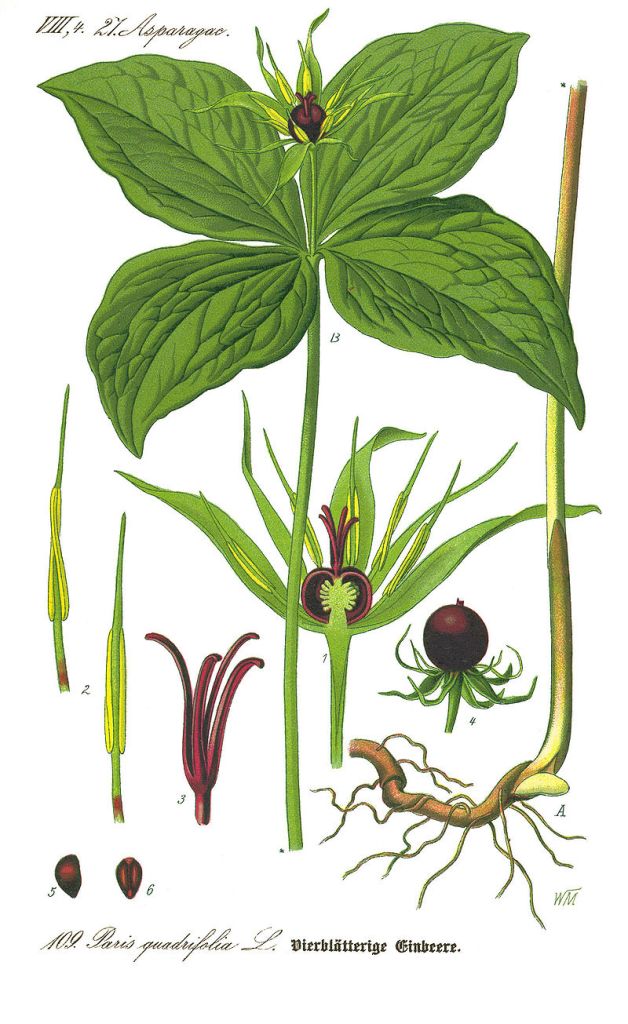
Paris quadrifolia or Herb-Paris
A rhizomatous, perennial herb of moist, calcareous, usually ancient, woodland, and occasionally found in grikes on open limestone pavement. It flowers and fruits most freely in the open stages of the coppice cycle, but persists in deep shade, and is well adapted to such conditions in managed woodland.
Each plant produces at most one blueberry-like berry, which is poisonous, as are other plant tissues. Poisonings are rare because the plant’s solitary berry has a repulsive taste that makes it difficult to mistake for a bilberry.
